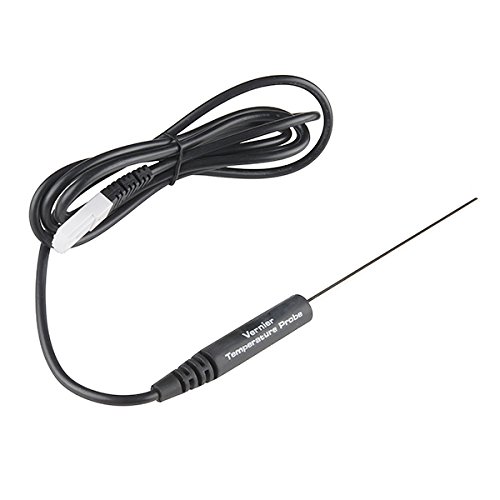Top 10 best vernier sensor: Which is the best one in 2018?
When you want to find vernier sensor, you may need to consider between many choices. Finding the best vernier sensor is not an easy task. In this post, we create a very short list about top 10 the best vernier sensor for you. You can check detail product features, product specifications and also our voting for each product. Let’s start with following top 10 vernier sensor:
1. Sensor adapter from Vernier to Analog
Description
Adapt Vernier BTA connectors to a 3 pin analog, 0 to 5 VDC input.2. Vernier Software Gas Pressure Sensor GPS-BTA
Feature
Gas Pressure SensorDescription
What's Included? Vernier Gas Pressure Sensor (2) tapered valve connectors inserted into a No. 5 stopper (1) tapered valve connector inserted into a No. 1 stopper (1) two-way valve (1) 18 inch Tygon tubing with Luer Lock connectors (1) 20 mL syringe (2) transpiration tubing clamps (white) User Manual.3. PH-BTA - Vernier pH Sensor - Vernier pH Sensor - Each
Feature
Vernier pH SensorDescription
General-purpose pH Sensors can be used across disciplines, with applications in chemistry, biology, middle school science, and environmental science. -Automated Data Collection -Graphing -Data Analysis -For Titrations, Studies of Household Acids and Bases, and More -Ideal for Use in Multiple Disciplines Advantages of these sensors include automated data collection, graphing, and data analysis. Typical activities using pH Sensors include acid-base titrations, studies of household acids and bases, monitoring pH change during chemical reactions or in an aquarium as a result of photosynthesis, investigations of acid rain and buffering, and analysis of water quality in streams and lakes.4. SAL-ST - Salinity Standard 35 PPT 500 mL - Vernier Salinity Sensor - Each
Feature
Salinity Standard 35 ppt 500 mLDescription
Easily and precisely measure the total dissolved salt content in ocean or brackish water. Range: 0-50 ppt. Resolution : 0.02 ppt .5. LS-BTA - Light Sensor - Vernier Light Sensor - Each
Feature
Light SensorDescription
Perfect for studying a wide variety of concepts. -For inverse square law experiments or for studying polarizers, reflectivity, or solar energy The Light Sensor approximates the human eye in spectral response and can be used over three different illumination ranges, which you select with a switch. For educational use only.6. GPS-BTA - Gas Pressure Sensor - Vernier Gas Pressure Sensor - Each
Feature
Gas Pressure SensorDescription
The Gas Pressure Sensor has enough resolution and range to work for all subject areas -Airtight Tubing Clamps for Transpiration Experiments -Fittings for Respiration Experiments -Enough Range for Boyle's Law Experiments -Sufficient Resolution for Vapor Pressure or Pressure-Temperature Experiments Chemistry teachers will find that it has enough range for Boyle's law experiments (0 to 2.1 atm) yet provides sufficient resolution for vapor pressure or pressure-temperature experiments (0.40 mm Hg with LabQuest). For biology teachers,the package includes airtight tubing clamps for transpiration experiments and fittings for respiration experiments in small containers.7. Vernier Sensor - Stainless Steel Temperature Probe
Feature
Vernier Sensor - Stainless Steel Temperature ProbeDescription
Features Documents This Is The Stainless Steel Temperature Probe, A Tough Little Vernier Sensor That Can Be Used To Measure The Temperature Of Organic Liquids And Even Salt Solutions, Acids, And Bases (Just Don'T Mix The Last Two). This Sensor Probe Can Be Used The Same As Almost Any Other Thermometer For Experiments And In A Multitude Of Fields Like Chemistry, Biology, Earth Science, And More.Each Sensor Probe Has A Temperature Range Of -40 To 135C (C40 To 275F). Make Sure Not To Use This Probe In Situations Where The Temperature Is 150C, This Is The Maximum Temperature The Probe Can Tolerate Without Damage.Vernier Software And Technology Has Been A Leader In Data Collection And Analysis For Educators World-Wide. They Were Amongst The First Companies To Design And Promote The Use Of Computers, Sensors, And Data Collection In K-12 Classroom Laboratory Experiments.Note: Due To ManufacturerS Restrictions, We Can Only Ship These To The Usa. Sorry World.8. PH-SS - pH Storage Solution 500 mL - Vernier pH Sensor - Each
Feature
pH Storage Solution 500 mLDescription
General-purpose pH Sensors can be used across disciplines, with applications in chemistry, biology, middle school science, and environmental science. -Automated Data Collection -Graphing -Data Analysis -For Titrations, Studies of Household Acids and Bases, and More -Ideal for Use in Multiple Disciplines Advantages of these sensors include automated data collection, graphing, and data analysis. Typical activities using pH Sensors include acid-base titrations, studies of household acids and bases, monitoring pH change during chemical reactions or in an aquarium as a result of photosynthesis, investigations of acid rain and buffering, and analysis of water quality in streams and lakes.9. Vernier Software Dual Range Force Sensor DFS-BTA
Feature
Dual Range Force SensorDescription
Dual-range force sensor (for labquest labpro go! link easylink cbl 2 and cbl)..The dual-range force sensor has two ranges: +/- 10n or +/- 50n. It can be easily mounted on a ring stand or dynamics cart (mounting bracket included) or used as a replacement for a hand-held spring scale. Use it to study friction simple harmonic motion impact in collisions or centripetal force. This force sensor is used for experiments in our physics physical science and middle school science lab manuals. Easily mounted on a ring stand or dynamics cart or used as a replacement for a hand-held spring scale; two ranges: +/10 and +/50 newtons (push/pull); purposes/functions: study friction simple harmonic motion impact in collisions or centripetal force; this force sensor is used for experiments in vernier's physics and physical science lab manuals; course usage: physics & physical science.10. WDSS - Wireless Dynamics Sensor System - Vernier Wireless Dynamics Sensor System - Each












Recent Comments